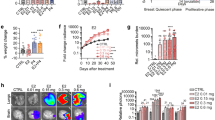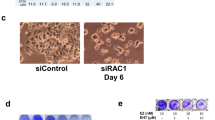Abstract
Estrogen receptor α (ERα) is a ligand-inducible transcription factor that acts to regulate gene expression by binding to palindromic DNA sequence, known as the estrogen response element, in promoters of estrogen-regulated genes. In breast cancer ERα plays a central role, where estrogen-regulated gene expression leads to tumor initiation, growth and survival. As an approach to silencing estrogen-regulated genes, we have studied the activities of a fusion protein between ERα and the promyelocytic leukemia zinc-finger (PLZF) protein, a transcriptional repressor that acts through chromatin remodeling. To do this, we have developed lines from the estrogen-responsive MCF-7 breast cancer cell line in which the expression of the fusion protein PLZF-ERα is conditionally regulated by tetracycline and shows that these feature long-term silencing of the expression of several well-characterized estrogen-regulated genes, namely pS2, cathepsin-D and the progesterone receptor. However, the estrogen-regulated growth of these cells is not inhibited unless PLZF-ERα expression is induced, an observation that we have confirmed both in vitro and in vivo. Taken together, these results show that PLZF-ERα is a potent repressor of estrogen-regulated gene expression and could be useful in distinguishing estrogen-regulated genes required for the growth of breast cancer cells.
This is a preview of subscription content, access via your institution
Access options
Subscribe to this journal
Receive 12 print issues and online access
$259.00 per year
only $21.58 per issue
Buy this article
- Purchase on Springer Link
- Instant access to full article PDF
Prices may be subject to local taxes which are calculated during checkout





Similar content being viewed by others
References
Kelsey JL, Berkowitz GS . Breast cancer epidemiology. Cancer Res 1988; 48: 5615–5623.
Ali S, Coombes RC . Endocrine-responsive breast cancer and strategies for combating resistance. Nat Rev Cancer 2002; 2: 101–112.
Buzdar A, Howell A . Advances in aromatase inhibition: clinical efficacy and tolerability in the treatment of breast cancer. Clin Cancer Res 2001; 7: 2620–2635.
Chawla A, Repa JJ, Evans RM, Mangelsdorf DJ . Nuclear receptors and lipid physiology: opening the X-files. Science 2001; 294: 1866–1870.
Tsai MJ, O'Malley BW . Molecular mechanisms of action of steroid/thyroid receptor superfamily members. Annu Rev Biochem 1994; 63: 451–486.
Luger K et al. Crystal structure of the nucleosome core particle at 2.8 A resolution. Nature 1997; 389: 251–260.
Cheung P, Allis CD, Sassone-Corsi P . Signaling to chromatin through histone modifications. Cell 2000; 103: 263–271.
Jenuwein T, Allis CD . Translating the histone code. Science 2001; 293: 1074–1080.
Grunstein M . Histone acetylation in chromatin structure and transcription. Nature 1997; 389: 349–352.
Workman JL, Kingston RE . Alteration of nucleosome structure as a mechanism of transcriptional regulation. Annu Rev Biochem 1998; 67: 545–579.
Glass CK, Rosenfeld MG . The coregulator exchange in transcriptional functions of nuclear receptors. Genes Dev 2000; 14: 121–141.
McKenna NJ, O'Malley BW . Combinatorial control of gene expression by nuclear receptors and coregulators. Cell 2002; 108: 465–474.
Chen H et al. Regulation of hormone-induced histone hyperacetylation and gene activation via acetylation of an acetylase. Cell 1999; 98: 675–686.
Brehm A, Kouzarides T . Retinoblastoma protein meets chromatin. Trends Biochem Sci 1999; 24: 142–145.
Ng HH, Bird A . DNA methylation and chromatin modification. Curr Opin Genet Dev 1999; 9: 158–163.
Bird AP, Wolffe AP . Methylation-induced repression – belts, braces, and chromatin. Cell 1999; 99: 451–454.
O'Neill LP et al. A developmental switch in H4 acetylation upstream of Xist plays a role in X chromosome inactivation. EMBO J 1999; 18: 2897–2907.
Fuks F et al. DNA methyltransferase Dnmt1 associates with histone deacetylase activity. Nat Genet 2000; 24: 88–91.
Fuks F et al. Dnmt3a binds deacetylases and is recruited by a sequence-specific repressor to silence transcription. EMBO J 2001; 20: 2536–2544.
Robertson KD . DNA methylation, methyltransferases, and cancer. Oncogene 2001; 20: 3139–3155.
Robertson KD et al. DNMT1 forms a complex with Rb, E2F1 and HDAC1 and represses transcription from E2F-responsive promoters. Nat Genet 2000; 25: 338–342.
Borrow J et al. The translocation t(8;16)(p11;p13) of acute myeloid leukaemia fuses a putative acetyltransferase to the CREB-binding protein. Nat Genet 1996; 14: 33–41.
Carapeti M, Aguiar RC, Goldman JM, Cross NC . A novel fusion between MOZ and the nuclear receptor coactivator TIF2 in acute myeloid leukemia. Blood 1998; 91: 3127–3133.
Chen Z et al. Fusion between a novel Kruppel-like zinc finger gene and the retinoic acid receptor-alpha locus due to a variant t(11;17) translocation associated with acute promyelocytic leukaemia. EMBO J 1993; 12: 1161–1167.
He LZ et al. Distinct interactions of PML-RARalpha and PLZF-RARalpha with co-repressors determine differential responses to RA in APL. Nat Genet 1998; 18: 126–135.
Lin RJ et al. Role of the histone deacetylase complex in acute promyelocytic leukaemia. Nature 1998; 391: 811–814.
Grignani F et al. Fusion proteins of the retinoic acid receptor-alpha recruit histone deacetylase in promyelocytic leukaemia. Nature 1998; 391: 815–818.
Guidez F et al. Reduced retinoic acid-sensitivities of nuclear receptor corepressor binding to PML- and PLZF-RARalpha underlie molecular pathogenesis and treatment of acute promyelocytic leukemia. Blood 1998; 91: 2634–2642.
David G et al. Histone deacetylase associated with mSin3A mediates repression by the acute promyelocytic leukemia-associated PLZF protein. Oncogene 1998; 16: 2549–2556.
Green S, Issemann I, Sheer E . A versatile in vivo and in vitro eukaryotic expression vector for protein engineering. Nucleic Acids Res 1988; 16: 369.
Tora L et al. The human estrogen receptor has two independent nonacidic transcriptional activation functions. Cell 1989; 59: 477–487.
Chen D, Pace PE, Coombes RC, Ali S . Phosphorylation of human estrogen receptor alpha by protein kinase A regulates dimerization. Mol Cell Biol 1999; 19: 1002–1015.
Ali S et al. Production and characterization of monoclonal antibodies recognising defined regions of the human oestrogen receptor. Hybridoma 1993; 12: 391–405.
Reid A et al. Leukemia translocation gene, PLZF, is expressed with a speckled nuclear pattern in early hematopoietic progenitors. Blood 1995; 86: 4544–4552.
Berthois Y, Katzenellenbogen JA, Katzenellenbogen BS . Phenol red in tissue culture media is a weak estrogen: implications concerning the study of estrogen-responsive cells in culture. Proc Natl Acad Sci USA 1986; 83: 2496–2500.
Horwitz KB, McGuire WL . Nuclear mechanisms of estrogen action. Effects of estradiol and anti-estrogens on estrogen receptors and nuclear receptor processing. J Biol Chem 1978; 253: 8185–8191.
Kastner P et al. Two distinct estrogen-regulated promoters generate transcripts encoding the two functionally different human progesterone receptor forms A and B. EMBO J 1990; 9: 1603–1614.
Brown AM, Jeltsch JM, Roberts M, Chambon P . Activation of pS2 gene transcription is a primary response to estrogen in the human breast cancer cell line MCF-7. Proc Natl Acad Sci USA 1984; 81: 6344–6348.
Morisset M, Capony F, Rochefort H . The 52-kDa estrogen-induced protein secreted by MCF7 cells is a lysosomal acidic protease. Biochem Biophys Res Commun 1986; 138: 102–109.
Klinge CM . Estrogen receptor interaction with estrogen response elements. Nucleic Acids Res 2001; 29: 2905–2919.
Shang Y et al. Cofactor dynamics and sufficiency in estrogen receptor-regulated transcription. Cell 2000; 103: 843–852.
Metivier R et al. Estrogen receptor-alpha directs ordered, cyclical, and combinatorial recruitment of cofactors on a natural target promoter. Cell 2003; 115: 751–763.
Acknowledgements
We are grateful to members of the group for advice and support and to David Peston for immunohistochemical staining. This work was supported by the Charing Cross and Hammersmith Hospitals Trustees, the Prostate Cancer Charity, CR UK, the Wellcome Trust, the AICR, BBSRC and MRC.
Author information
Authors and Affiliations
Rights and permissions
About this article
Cite this article
Buluwela, L., Pike, J., Mazhar, D. et al. Inhibiting estrogen responses in breast cancer cells using a fusion protein encoding estrogen receptor-α and the transcriptional repressor PLZF. Gene Ther 12, 452–460 (2005). https://doi.org/10.1038/sj.gt.3302421
Received:
Accepted:
Published:
Issue Date:
DOI: https://doi.org/10.1038/sj.gt.3302421
Keywords
This article is cited by
-
BTB protein family and human breast cancer: signaling pathways and clinical progress
Journal of Cancer Research and Clinical Oncology (2023)
-
The androgen receptor is a tumor suppressor in estrogen receptor–positive breast cancer
Nature Medicine (2021)
-
Expression of H1.5 and PLZF in granulosa cell tumors and normal ovarian tissues: a short report
Cellular Oncology (2014)
-
The liver receptor homolog-1 regulates estrogen receptor expression in breast cancer cells
Breast Cancer Research and Treatment (2011)
-
Transient over-expression of estrogen receptor-α in breast cancer cells promotes cell survival and estrogen-independent growth
Breast Cancer Research and Treatment (2011)



